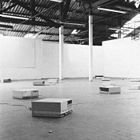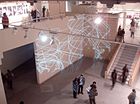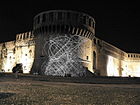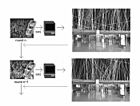- Maurizio Bolognini
-
Maurizio Bolognini (born July 27, 1952) is an Italian post-conceptual artist. His installations explore the potential and implications of new media technologies starting from the minimal and abstract activation of processes that are beyond artist's control, at the crossroads between generative art, public art and e-democracy.
Contents
Background
Maurizio Bolognini was born in Brescia, Italy. Before working as a media artist, he received degrees in urban planning and social sciences from the University of Birmingham, UK, and the University IUAV of Venice. He later worked extensively as a researcher in the field of structured communication techniques (such as the real-time Delphi method), and to their application to electronic democracy.[1] His research interests and a wide range of artworks have focused on three main dimensions of digital technologies:[2]
 Programmed Machines, Nice, France, 1992-97
Programmed Machines, Nice, France, 1992-97 Interactive installation, Art Palace, Cairo, 2008
Interactive installation, Art Palace, Cairo, 2008
— the possibility of delegating creative functions to generative devices, such as in his Programmed Machines series. From the beginning (1988), this series introduced the concept of infinity into his work,[3] and focused on "the experience of the disproportion (and disjunction) between artist and the artwork, which is made possible by computer-based technologies";[4]
— the space-time flows of technological communication, and the interplay of geographical and electronic space, which gave rise to works such as Altavista (1996),[5] Antipodes (1998),[6] and Museophagia (1998–99), in which the use of web-based communication flows focused on their physical infrastructure and was often combined with actions taken over long distance travels;[7]
— the introduction of new forms of interactivity based upon structured communication techniques and e-democracy, which he used in installations such as the CIMs (Collective Intelligence Machines, since 2000)[8] and ICB (Interactive Collective Blue, 2006).[9]
Some of these works were developed through intense cooperation with Artmedia, the Laboratory of the Aesthetics of Media and Communication, founded in 1985 at the University of Salerno, and the Laboratory Museum of Contemporary Art (MLAC), Sapienza University of Rome. In 2003 Domenico Scudero, the MLAC curator, published a monograph book on Bolognini’s work.[10] In 2004 Artmedia organized a show, curated by its director Mario Costa, theorist of the "technological sublime", who aimed to highlight a European tendency in new media art. The show, held at the Sannio Museum, presented works by Roy Ascott (English), Maurizio Bolognini (Italian), Fred Forest (French), Richard Kriesche (Austrian) and Mit Mitropoulos (Greek).[11]
Programmed machines
Interactive installation (CIMs series), Imola, Italy, 2006
In 1988 Bolognini began using personal computers to generate a flux of continuously expanding random images. In the 1990s, he programmed hundreds of these computers and left them to run ad infinitum (most of these are still working). About his Programmed Machines he wrote: "I do not consider myself an artist who creates certain images, and I am not merely a conceptual artist. I am one whose machines have actually traced more lines than anyone else, covering boundless surfaces. I am not interested in the formal quality of the images produced by my installations but rather in their flow, their limitlessness in space and time, and the possibility of creating parallel universes of information made up of kilometres of images and infinite trajectories. My installations serve to generate out-of-control infinities."[12]
The Programmed Machines series (and in particular the Sealed Computers, since 1992, whose monitor buses are closed with wax and whose graphic outputs cannot be displayed) is considered one of his most significant works.[13] These Machines were exhibited in many museums and art galleries, in Europe and the United States. In 2003 some sixty Machines were exhibited in three simultaneous shows arranged at the Laboratory Museum of Contemporary Art in Rome, the CACTicino Center for Contemporary Art in Switzerland, and the Williamsburg Art & Historical Center in New York. In 2005 the Villa Croce Museum of Contemporary Art, Genoa, dedicated a retrospective and a monograph to these works.[14]
Since 2000 Bolognini has concentrated on combining the Programmed Machines with communication devices, as in the Collective Intelligence Machines series. These are interactive installations connecting some of his generative machines to the mobile telephone network,[15] to allow a real-time Delphi-like interaction by members of the public. These installations delegate choices to both electronic devices and processes of communication and e-democracy with the aim of involving the audience in new forms of “generative, interactive and public art”.[16]
Maurizio Bolognini's work is considered relevant to the theory of the "technological sublime"[17] and the aesthetics of flux (as opposed to the aesthetics of form),[18] and has been seen as a further development of conceptual art within new media art.[19]
See also
References
- ^ Maurizio Bolognini (2001) (in Italian), Democrazia elettronica, Rome: Carocci Editore, ISBN 8843020358, http://www.bolognini.org/bolognini_DE.htm. Simonetta Lux (2007) (in Italian), Arte ipercontemporanea, Rome: Gangemi Editore, ISBN 9788849211146, http://www.gangemi.com/scheda.asp?id=8849211147, pp. 480-481.
- ^ Maurizio Bolognini (2008) (in Italian), Postdigitale, Rome: Carocci Editore, ISBN 9788843047390, http://www.bolognini.org/bolognini_PDIG.htm, chap. 1.
- ^ Sandra Solimano (ed.) (2005), Maurizio Bolognini. Programmed Machines 1990-2005, Genoa: Villa Croce Museum of Contemporary Art, Neos, ISBN 8887262470.
- ^ Maurizio Bolognini (2008), Postdigitale, Rome: Carocci Editore, p. 24.
- ^ Fred Forest (2008) (in French), Art et Internet, Paris: Cercle d'art, ISBN 9782702208649, http://www.cercledart.com/catalogue_ouvrages/9782_702208649_art_et_internet, pp. 67-71.
- ^ Vincenzo Cuomo, "L’altro nella rete", Kainós, 2, 2003.
- ^ Derrick de Kerckhove, "Museophagia - The art gallery in the age of its digital reproduction", in Piero Cavellini (ed.) (1999), Maurizio Bolognini. Raptus, Brescia: Nuovi Strumenti, pp. 19-25.
- ^ Maurizio Bolognini, "De l'interaction à la démocratie. Vers un art génératif post-digital" / "From interactivity to democracy. Towards a post-digital generative art", Artmedia X Proceedings. Paris, 2010.
- ^ Maurizio Bolognini (2008), Postdigitale, Rome: Carocci Editore, pp. 20-21.
- ^ Domenico Scudero (ed.) (2003) (in Italian), Maurizio Bolognini: installazioni, disegni, azioni, Rome: Lithos, ISBN 8886584717.
- ^ Mario Costa (2003), New Technologies: Ascott, Bolognini, Forest, Kriesche, Mitropoulos. Artmedia, University of Salerno, Museo del Sannio.
- ^ Maurizio Bolognini (2008), Postdigitale, Rome: Carocci Editore, p. 34. See also Sandra Solimano (ed.) (2005), Maurizio Bolognini. Programmed Machines 1990-2005, Genoa: Villa Croce Museum of Contemporary Art, Neos, p. 15.
- ^ Andreas Broeckmann, "Image, Process, Performance, Machine: Aspects of an Aesthetics of the Machinic", in Oliver Grau (ed.) (2007), Media Art Histories, Cambridge: MIT Press, ISBN 0262072793, http://leonardo.info/isast/leobooks/books/grau2.html, pp. 204-205. Andreas Broeckmann, "Software Art Aesthetics", in David Olivier Lartigaud (ed.) (2008) (in French), Art orienté programmation. Paris: Sorbonne University. Inke Arns (2005), "Code as Performative Speech Act", Artnodes, 5, Open University of Catalonia. Mario Costa (2006) (in Italian), Dimenticare l’arte, Milan: Franco Angeli, ISBN 9788846463647, http://www.francoangeli.it/Ricerca/Scheda_Libro.asp?ID=12843&Tipo=Libro&strRicercaTesto=&titolo=dimenticare+l++arte%2E+nuovi+orientamenti+nella+teoria+e+nella+sperimentazione+estetica, pp. 137-138. Simonetta Lux (2007), Arte ipercontemporanea, Rome: Gangemi Editore, pp. 374-393. Domenico Scudero (ed.) (2003), Maurizio Bolognini: installazioni, disegni, azioni, Rome: Lithos, pp. 9-49. Andres Ramirez Gaviria (2004), Approaches in Multimedia Art, New York: New York Arts Books, pp. 33-35. Pedrini, E. (ed.) (2003), Maurizio Bolognini: Between Utopia and Infochaos, New York: Williamsburg Art & Historical Center. Mario Costa (2007) (in Italian), L'oggetto estetico e la critica, Salerno: Edisud, ISBN 9788896154, pp. 31-43. Mario Costa, Vittorio Cafagna (2005), Phenomenology of New Tech Arts, Artmedia, University of Salerno, Department of Philosophy, Department of Mathematics and Informatics, pp. 18-20. Robert C. Morgan, "Maurizio Bolognini: The Problematic of Art", Luxflux, 4, 2004, pp. 94-101.
- ^ Sandra Solimano (ed.) (2005), Maurizio Bolognini. Programmed Machines 1990-2005, Genoa: Villa Croce Museum of Contemporary Art, Neos.
- ^ Maurizio Bolognini, "The SMSMS Project: Collective Intelligence Machines in the Digital City", Leonardo/MIT Press, 37/2, 2004, pp. 147-149; Maurizio Bolognini, "Infoinstallations et ville numérique", Ligeia. Dossiers sur l’art, 45-48. Paris, 2003, pp. 57-60.
- ^ Maurizio Bolognini (2010), "De l'interaction à la démocratie. Vers un art gėnėratif post-digital", Artmedia X Proceedings, Paris.
- ^ Mario Costa (2003), New Technologies: Ascott, Bolognini, Forest, Kriesche, Mitropoulos, Artmedia, University of Salerno, Museo del Sannio, pp. 7-12; Andreas Broeckmann, "Software Art Aesthetics", in David Olivier Lartigaud (ed.) (2008), Art orienté programmation, Paris: Sorbonne University.
- ^ Mario Costa (2006), Dimenticare l’arte, Milan: Franco Angeli; Mario Costa (2010) (in Italian), Arte contemporanea ed estetica del flusso, Vercelli: Edizioni Mercurio, ISBN 9788895522616, pp. 123-124.
- ^ Sandra Solimano, "Metaphors and Moves", in Maurizio Bolognini. Personal Infinity, Brescia: Nuovi Strumenti, pp. 17-18; Robert C. Morgan, "Maurizio Bolognini: The Problematic of Art", Luxflux, 4, 2004, p. 96.
External links
Categories:- Contemporary artists
- Conceptual artists
- New media artists
- Media theorists
- Transdisciplinarity
- Living people
- Postmodern artists
- 1952 births
Wikimedia Foundation. 2010.





